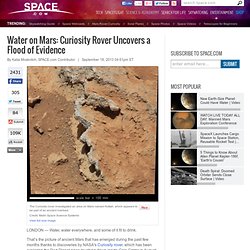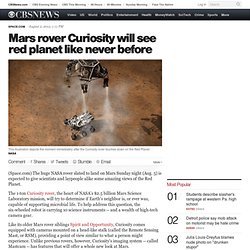

The Curiosity Rover Has Arrived At Its Primary Scientific Target! Curiosity Ready to Drill for Gold at the Kimberley. Black gold, that is: organic material, which could be a biomarker (sign of past life), the holy grail of Mars exploration.

Last December at the fall meeting of the American Geophysical Union in San Francisco, MSL Project Scientist John Grotzinger talked about what the team learned at Yellowknife Bay, and why they would stop and drill again at a place named “the Kimberley.” The mudstones at Yellowknife Bay had been exposed recently—to a geologist—less than 100 million years ago. They deduced that this was due to erosion of overlying layers by the wind, and that even younger exposure ages should be possible closer to the scarp. This matters because Mars doesn’t have a magnetosphere and thick atmosphere like Earth, protecting us from energetic particles from space that break down organic material. Thus, rocks that have been near the surface of Mars for a long time (geologically speaking) are less likely to contain complex organic material.
NASA has just made an incredible discovery about water on Mars. Water on Mars: Curiosity Rover Uncovers a Flood of Evidence. LONDON — Water, water everywhere, and some of it fit to drink.

That’s the picture of ancient Mars that has emerged during the past few months thanks to discoveries by NASA's Curiosity rover, which has been exploring the Red Planet since touching down inside Gale Crater in August 2012. The announcements have come in dribs and drabs, but presented together recently here at the European Planetary Science Congress, they provide compelling evidence that Mars was quite wet in the distant past. [The Search for Water on Mars (Photos)] During many sessions at the conference, which was held Sept. 8 to Sept. 13 in London, scientists presented details of the rover’s most exciting finds, made before it began the long drive toward the towering Mount Sharp this past July.
And the words that could be heard most often were hydrogen, hydration, rocks and water. Here's why everybody is freaking out about methane on Mars. Timeline Photos. News Bummers: Poison Fog, Sad Sperm & SAM. Awesome Billion-Pixel Panorama Spins You Around Curiosity Rover's Worksite on Mars. NASA’s Curiosity rover is constantly toiling away to deliver great science from Mars and make amazing new discoveries.

Now, the agency has released this interactive 1.3-billion-pixel panorama to transport you right to the rover’s most recent worksite and take a spin around some of its latest experimental investigations. (Go to full screen for best Oh-yeah-I’m-on-Mars feeling) Curiosity is taking one last look at the minerals and composition of an area nicknamed “Rocknest” before it heads off to the base of Mount Sharp, its distant target. This panorama stitches 850 images taken by the rover’s many cameras between Oct. 5 and Nov. 16 to give you an immersive view of Rocknest. It is similar to a previous 4-billion-pixel panorama put together by amateur image-processor Andrew Bodrov, though it shows a somewhat different area. Curiosity Confirms That Mars Was Once Capable of Harboring Life.
Mars Rover Fully Analyzes First Soil Samples. Mysterious Mars News. Curiosity's Descent. Complete MSL Curiosity Descent Interpolated HD. This is hands down the most breathtaking version of Curiosity's descent we've seen yet. Read the increasingly desperate tweets of Martian rock N165 as it is zapped by Curiosity. The next best thing to being there: NASAs Opportunity Rover captures 360 panorama of its base for the long Martian winter. By Eddie Wrenn PUBLISHED: 17:21 GMT, 7 July 2012 | UPDATED: 23:05 GMT, 7 July 2012 We might not be able to get there yet, but as NASA says, 'this is the next best thing'. From fresh rover tracks to an impact crater blasted billions of years ago, a newly completed view from the panoramic camera on NASA's Mars Exploration Rover Opportunity shows the ruddy terrain where the voyaging robot spent the Martian winter.
Curiosity rover: Martian solar day 2 - Fullscreen 360º VR Panorama. Liveblogging Curiosity's Arrival on Mars. Another from the UK here - stream on, fingers crossed.

Go Heath Robinson landing sequence, go. Can I ask why? Spaceflight Now. Curiosity Confirms That Mars Was Once Capable of Harboring Life. Today, science willing, Curiosity rover lands on Mars. Here's how to watch. This is it, guys.

Television in High Definition on UStream. TV. 7 Minutes of Terror: Curiosity Rover's Risky Mars Landing. Curiosity Rover's Mars Landing – How It Works. To Boldly Go Where No Man Has Gone Before. Here's how Curiosity will use its laser to search for the ingredients of life on Mars. Mars rover Curiosity will see red planet like never before. This illustration depicts the moment immediately after the Curiosity rover touches down on the Red Planet.

NASA (Space.com) The huge NASA rover slated to land on Mars Sunday night (Aug. 5) is expected to give scientists and laypeople alike some amazing views of the Red Planet. The 1-ton Curiosity rover, the heart of NASA's $2.5 billion Mars Science Laboratory mission, will try to determine if Earth's neighbor is, or ever was, capable of supporting microbial life. To help address this question, the six-wheeled robot is carrying 10 science instruments -- and a wealth of high-tech camera gear. Like its older Mars rover siblings Spirit and Opportunity, Curiosity comes equipped with cameras mounted on a head-like stalk (called the Remote Sensing Mast, or RSM), providing a point of view similar to what a person might experience. "It will take color in the same way as a consumer digital camera," said Michael Ravine, advanced projects manager at Malin.